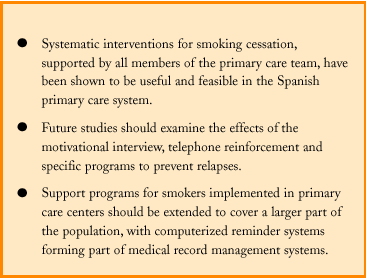Research on smoking in the primary care setting has traditionally centered on so-called brief interventions. This is because of practical considerations and their low cost, as well as historical tradition going back to Russell in 1979. In addition, brief interventions have been tested more frequently than other procedures, as shown in the review included in the latest edition of the Cochrane Library database (Silagy et al, 2002),1 which comprises 34 clinical trials involving more than 27 000 smokers. This analysis showed that the role of nursing staff was of fundamental importance (Rice et al, 2002).2
More recently, recommendations issued by different agencies such as the Center for Disease Control (CDC 2002)3 and WHO (2001)4 have noted the need for brief interventions to add motivational interviews, pharmacological therapy (nicotine replacement therapy [NRT] and bupropion) as strategies of first choice. These studies, however, have also noted the need to ensure that all health professionals (ie, physicians, nursing staff, pharmacists, midwives, and others), as fundamental elements of primary care, are involved in the intervention.
In this issue Alonso Fernández et al. describe an interesting study that centers on systematic minimal intervention with support from the nursing staff and appropriately used NRT. Notably, 27% of the participants in the program quit smoking a higher success rate than in similar studies. However, the authors caution that this figure was probably due to the better coordination between health professionals (physicians and nurses) and the use of pharmacological treatment (NRT). They also note certain limitations of their study, eg, the lack of a control group. However, this type of study, which is not strictly speaking experimental, and which examines results obtained under «normal» conditions during the visit to the physician´s office, are enormously valuable in that they enhance the credibility of such findings and support their applicability in our primary care setting.
In addition, the article points out some areas for future research, such as the evaluation of a specific intervention to prevent relapses, and the use of telephone counseling as part of support programs. Similar approaches can be found in a review of community-level interventions published by the Task Force on Community Prevention Services5, which «strongly recommends» the use of «health system strategies to improve the availability of effective cessation therapies» particularly interventions that provide telephone support in the context of multicomponent interventions.
A final point worth emphasizing is the authors´ own critique of the program´s coverage, which they estimated at only 4%. However, it is clear that primary care professionals play a fundamental role in strategies to make treatment of the problem more widely available, because of their contact with the entire population, and because primary care centers are the most appropriate place for such intervention. More active educational policies are probably needed, including specific undergraduate and graduate-level training or continuous medical education (Comité Nacional para la Prevención del Tabaquismo 2002).6 However, it is also necessary to incorporate systems that make it possible to identify smokers more frequently and thus increase the availability of medical help and support. In addition, information technology is likely to be useful, for example, as software programs that manage reminder, follow-up and medical record systems.3,5









